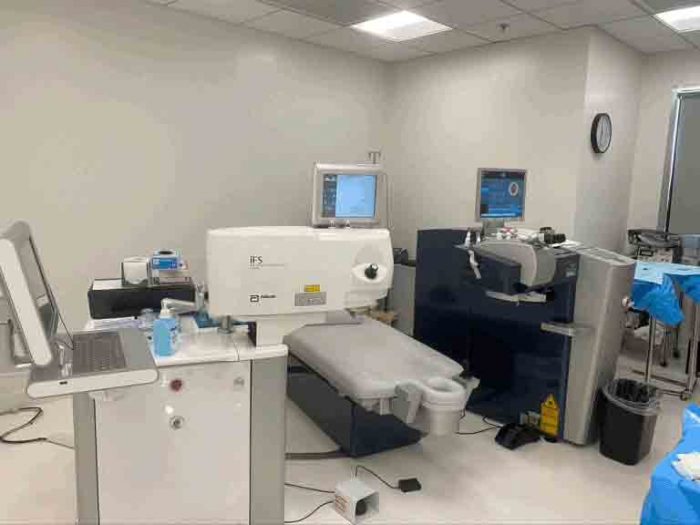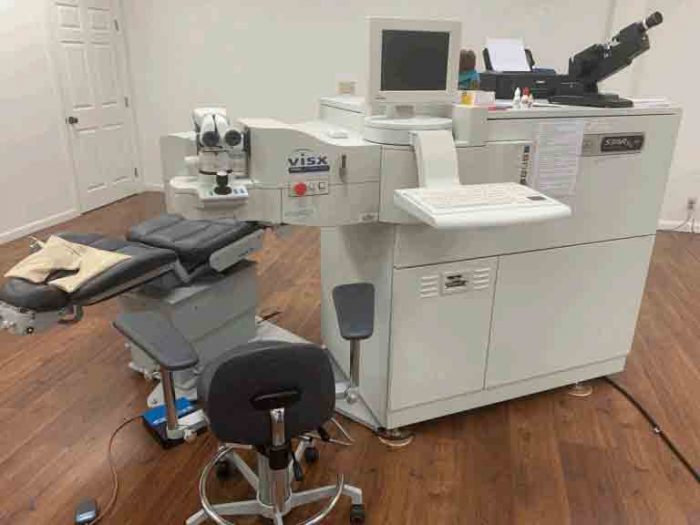

Lasik is a type of eye surgery in which an extremely precise computer-controlled laser is used to reshape the corneal surface so as to fix irregularities that have impaired your vision. The cornea is the clear front part of the eyeball. Lasik eye surgery deals with:
Myopia (nearsightedness), Farsightedness (hyperopia) and Astigmatism. It does not correct presbyopia, which prompts the need for reading glasses. Presbyopia affects everyone, as soon as we reach the age of 40-50. Presbyopia treatment must deal with the stiffening natural lens in the eye and weakening eye muscle, instead of just modifying the corneal surface.

Intralase and Allegretto lasers combo in our climate controlled Laser suite

iDesign visx laser with iris registration active tracking
We take a look at four variables to identify a person’s qualification for Lasik eye surgery which can be summarized in the mnemonic “PAST”.
Basic synonyms: Laser vision correction, all laser lasik, zlasik, ilasik, custom lasik, catz lasik, idesign lasik, Wavefront lasik, Wavefront optimized lasik. You might question why there are so many complicated names for a simple sounding treatment. This stems from the manufacturers trying to distinguish their machines from one another. We will definitely make it more clear in the next few paragraphs.
Lasik eye surgery has now been around for near about thirty years. It was introduced in the USA in the mid-nineties. At that time, if you were in school, in baby diapers or just a twinkle in your moms and dad’s eyes, you were a good prospect for Lasik eye surgery. If you are a Baby Boomer, the chances of still qualifying for Lasik vision correction are slim. You need to rather consider PIE, or Presbyopic Implant in Eye.
Lasik is a type of eye surgery in which an extremely precise computer-controlled laser is used to reshape the corneal surface so as to fix irregularities that have impaired your vision. The cornea is the clear front part of the eyeball. Lasik eye surgery deals with:
Myopia (nearsightedness), Farsightedness (hyperopia) and Astigmatism. It does not correct presbyopia, which prompts the need for reading glasses. Presbyopia affects everyone, as soon as we reach the age of 40-50. Presbyopia treatment must deal with the stiffening natural lens in the eye and weakening eye muscle, instead of just modifying the corneal surface.
Action 1: Designing a corneal flap using an automated machine or a femtosecond laser.
Action 2: iDesign Wavefront active track laser to change the thickness and shape of the cornea.
Step 3: Re-position the corneal flap, in its original place and seal it.
Lasik denotes Laser In-situ Keratomileusis, a procedure designed to “shape the cornea from within.” During Lasik surgical procedure, this is precisely what happens: your cornea is re-shaped using a state-of-the-art Excimer laser. The laser vaporizes tiny amounts of corneal tissue so the cornea is made less inclined, which then allows the light rays to focus on your retina correctly. This improves your eyes’ ability to focus, projecting a clear image on the retina, providing you with clear vision.
Lasik eye surgery is done to enhance natural vision and gain freedom from glasses and contact lenses. The eye cannot be made longer or shorter, so instead we alter the focusing power of the eye, by changing the shape of the cornea. Similar to a camera, where we can include or remove lenses to get an excellent image, lasers achieve this by changing the shape of the cornea, the clear front part of the eye. Before Lasik is performed, every microscopic irregularity that is impacting your vision will be mapped out using an advanced technology called Wavefront Diagnosis. This “map” of your eyes will then be used to direct the Excimer laser in re-shaping your cornea, assisting the laser target and correct each irregularity. The outcome is clear, unhindered vision that does not need dependency on glasses or contact lenses.
No, Lasik does not hurt at all at Khanna Vision Institute! This is something which is on everyone’s mind, whether they ask it or not. Many people are concerned if Lasik eye surgical treatment will be painful. They also wonder if they will be awake or asleep during the procedure. Some are concerned about keeping their eyes open, while others worry about holding their eyes still. Allow us to guarantee you that in Dr. Khanna’s hands, the surgical treatment is not painful. You might experience some pressure and feel the temperature of the liquids that are instilled into your eyes, yet IT IS NOT PAINFUL.
There are certain steps we take in our practice to keep the procedure a pleasurable experience. The first step is education about the treatment. Our wonderful team provides a preview of the laser suite and goes through the entire process with you from beginning to end. We motivate potential Lasik patients to speak to our patients that have actually had Lasik recently. This method minimizes anxiety. Xanax prior to the treatment also helps lessen the remaining stress. As we execute the procedure, we let you know about upcoming steps to ensure that nothing comes as a surprise.
Common Adverse Effects of LASIK
The most usual side effects of LASIK are:
– Dry eyes
– Itchy or burning eyes
– Increased sensitivity to light
– Halos and starbursts
– Glare around lights
– Loss of contrast sensitivity
These adverse effects are often temporary and will self-correct as your eyes adjust to their new shape. Dr. Khanna will give you the instructions on exactly how to deal with problems such as dry eyes and will examine other side effects during your follow-up visits at one of our Los Angeles clinics.
In really rare instances, a side effect of LASIK might be visual regression. Women who are on hormonal treatment are at a great risk for this complication. Nevertheless, as with other side effects of LASIK, visual regression usually self-corrects, particularly when medications that can cause it are temporarily suspended.
Before the treatment
Accurate, multiple measurements are essential. If the readings do not correlate with each other they must be repeated on a different day. Identification and treatment of dry eyes must begin prior to the Lasik surgical treatment. Improper or abnormal corneal shape/thinness need to be looked for carefully.
During Lasik Eye Surgery
The eye to be operated on should be identified and tested. Data entry into the laser needs to be verified by the surgeon and the laser technician. The lashes will be carefully covered. The flap and interface must be carefully washed and the flap apposed diligently.
After Lasik
Close follow up by the surgeon is the key in the post Lasik period, for early and complication-free recovery. Early flap problems need to be attended to, along with any kind of inflammation. Once again, dry eye management is crucial.
Virtual Consult: Free
Live Consult: Free – consists of screening for safety and a discussion with the Lasik Surgeon regarding the most effective choice of procedure.
Preoperative Examination: $350
The test includes all of these many measurements:
1. Lensometry
2. Auro-refraction
3. Uncorrected vision and best corrected vision
4. Manual refraction
5. Cycloplegic refraction
6. iDesign treatment measurements
7. Eye dominance test
8. Full slit light exam, including cornea exam and also ruling out cataracts
9. Fundus exam
10. OCT scan of the Optic Nerve, Macula and Cornea
11. Color corneal topography
Lasik Eye Surgery: $2825/Eye (consists of the following listed here):
1. Lasik or superlasik eye surgery
2. All laser suite, royality and assistant fees
3. Surgeon Fees
4. Dry eye therapy – a) Preservative free artificial tears b) Punctal occluder insertion c) Restasis, Xiidra or Sequa (one week supply)
5. Drops – one set of antibiotic and steroid drops required prior to and/or after surgical procedure
6. Postop Kit
7. Free parking
8. 12 months follow up exams
9. Life time enhancement guarantee with a yearly paid examination after the initial 12 months of protected post-operative visits
10. Affordable monthly payments (subject to credit check)
11. And a Swag bag (Rayban, Oakley or Prada designer sunglasses or Uber/Lyft ride on day of surgery or something special)